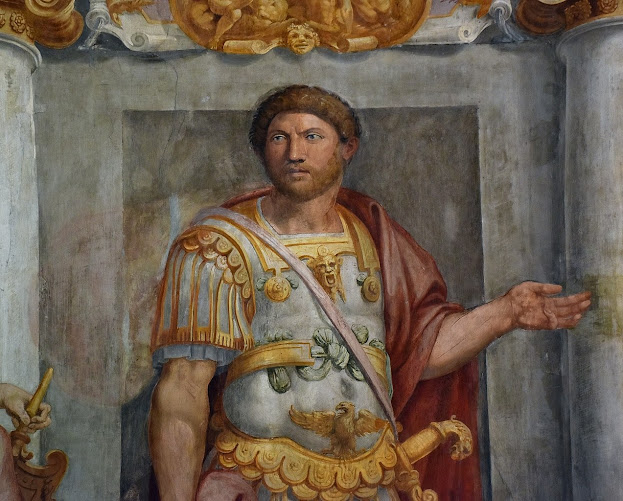The emperor Hadrian's tomb was erected on the right bank of the Tiber, between AD 134 and 139. Now known as the Castel Sant'Angelo, originally the mausoleum was a decorated cylinder, with a garden top and golden quadriga. Hadrian's ashes were placed here a year after his death in Baiae in 138, together with those of his wife Sabina, and his first adopted son, Lucius Aelius, who died in 138. Following this, the remains of succeeding emperors were also placed here, the last recorded deposition being Caracalla in 217 CE. But much of the tomb contents and decorations were lost when the building was converted to a military fortress in 401 CE then subsequently included in the Aurelian Walls by Flavius Honorius Augustus. The urns and ashes were scattered by Visigoth looters during Alaric's sack of Rome in 410, and the original decorative bronze and stone statuary were thrown down upon the attacking Goths when they besieged Rome in 537, as recounted by Procopius. In the 14th century the popes converted the tomb into a castle and connected it to St. Peter's Basilica by a covered fortified corridor called the Passetto di Borgo. It was also used as a prison and executions were performed in the inner courtyard.
I first visited the castle in 2005 when a friend and I walked there after spending the morning at St. Peter's and the Vatican Museums. At that time, however, photography was disappointingly not allowed inside the structure. But yesterday when I was researching the origins of a Roman relief I thought might be in the Castel Sant'Angelo, I was searching the images of the castle on Wikimedia Commons and discovered quite a number of excellent interior images, including this one of a fresco of Hadrian. Rome must have changed their policy on photography at this site! I encourage you to browse the images of this impressive monument on Wikimedia Commons.
They certainly refreshed my memory of my experience there! You can find the fresco of Hadrian in the room known as the Sala Paolina. This image is courtesy of Wikimedia Commons contributor, Vassil.
 |
| Fresco of the Emperor Hadrian in the Sala Paolina of Castel Sant'Angelo courtesy of Wikimedia Commons contributor, Vassil. |
No comments:
Post a Comment